side Acura RDX 2018 Owner's Manual
[x] Cancel search | Manufacturer: ACURA, Model Year: 2018, Model line: RDX, Model: Acura RDX 2018Pages: 453, PDF Size: 20.13 MB
Page 3 of 453

Contents
This owner’s manual should be considered a permanent part of the
vehicle and should remain with the vehicle when it is sold.
This owner’s manual covers all models of your vehicle. You may find
descriptions of equipment and features that are not on your
particular model.
Images throughout this owner’s manual (including the front cover)
represent features and equipment that are available on some, but
not all, models. Your particular mo del may not have some of these
features.
This owner’s manual is for vehicles sold in the United States and
Canada.
The information and specifications in cluded in this publication were
in effect at the time of approval for printing. Honda Motor Co., Ltd.
reserves the right, however, to discontinue or change specifications
or design at any time without notice and without incurring any
obligation.2 Safe Driving P. 25
For Safe Driving P. 26 Seat Belts P. 31 Airbags P. 39
2Instrument Panel P. 67
Indicators P. 68 Gauges and Multi-Information Display P. 95
2Controls P. 119
Setting the Clock P. 120 Locking and Unlocking the Doors P. 121
Opening and Closing the Moonroof P. 145
Adjusting the Seats P. 164
2Features P. 187
Audio System* P. 188 Audio System Basic Operation* P. 192
HomeLink ® Universal Transceiver P. 224
2 Driving P. 257
Before Driving P. 258 Towing a Trailer P. 263
Parking Your Vehicle P. 332Multi-View Rear Camera P. 340
2Maintenance P. 345
Before Performing Maintenance P. 346 Maintenance MinderTM P. 349
Checking and Maintaining Wiper Blades P. 372
Climate Control System Main tenance P. 388 Cleaning P. 389
2Handling the Unexpected P. 395
Tools P. 396 If a Tire Goes Flat P. 397
Overheating P. 420 Indicator, Coming On/Blinking P. 422
2Information P. 431
Specifications P. 432 Identification Numbers P. 434
Emissions Testing P. 437 Warranty Coverages P. 439
Page 8 of 453
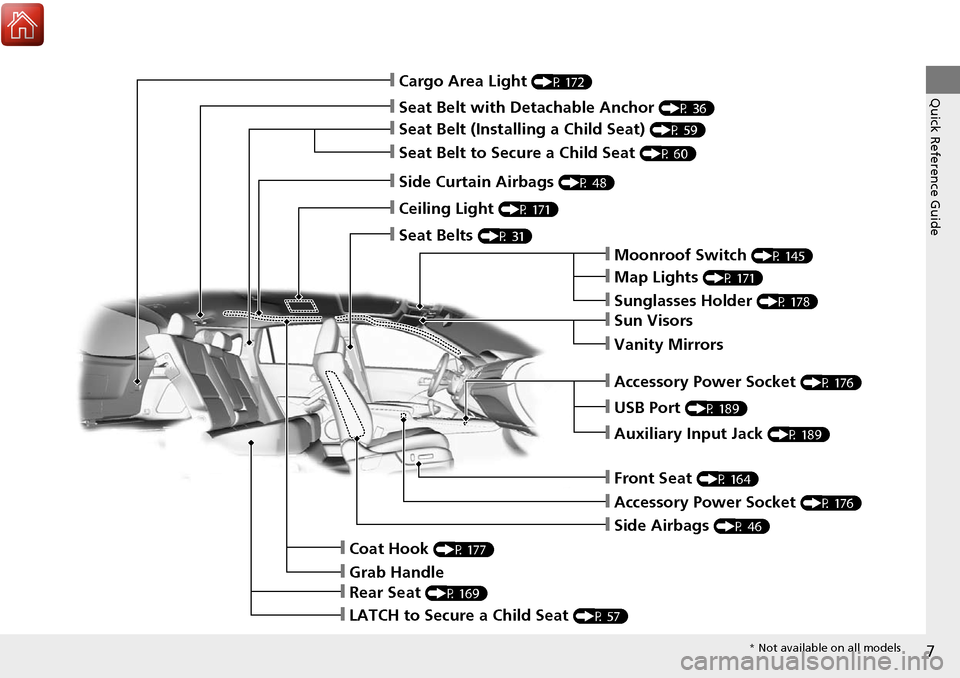
7
Quick Reference Guide❙Cargo Area Light (P 172)
❙Seat Belt with Detachable Anchor (P 36)
❙Seat Belt (Installing a Child Seat) (P 59)
❙Seat Belt to Secure a Child Seat (P 60)
❙Side Curtain Airbags (P 48)
❙Ceiling Light (P 171)
❙Seat Belts (P 31)
❙Moonroof Switch (P 145)
❙Map Lights (P 171)
❙Sunglasses Holder (P 178)
❙Sun Visors
❙Vanity Mirrors
❙USB Port (P 189)
❙Auxiliary Input Jack (P 189)
❙Front Seat (P 164)
❙Side Airbags (P 46)
❙Coat Hook (P 177)
❙Grab Handle
❙Rear Seat (P 169)
❙LATCH to Secure a Child Seat (P 57)
❙Accessory Power Socket (P 176)
❙Accessory Power Socket (P 176)
* Not available on all models
Page 9 of 453

Visual Index
8
Quick Reference Guide
❙Windshield Wipers (P 153, 372)
❙How to Refuel (P 342)
❙High-Mount Brake Light (P 371)
❙Opening/Closing the Tailgate
(P 133)
❙Rear Wiper (P 155, 374)
❙Back-Up Lights (P 370)
❙Brake/Taillights (P 368)
❙Rear Turn Signal Lights (P 368)
❙Rear Side Marker Lights (P 368)
❙Power Door Mirrors (P 162)
❙Maintenance Under the Hood (P 353)
❙Fog Lights* (P 152, 365)
❙Multi-View Rear Camera (P 340)
❙Tailgate Release Button (P 134)
❙Headlights (P 149, 365)
❙Front Turn Signal Lights/Parking Lights/
Daytime Running Lights
(P 149, 367)
❙Side Marker Lights (P 149, 367)
❙Tires (P 376, 397)
❙Door Lock/Unlock Control (P 125)
Page 13 of 453
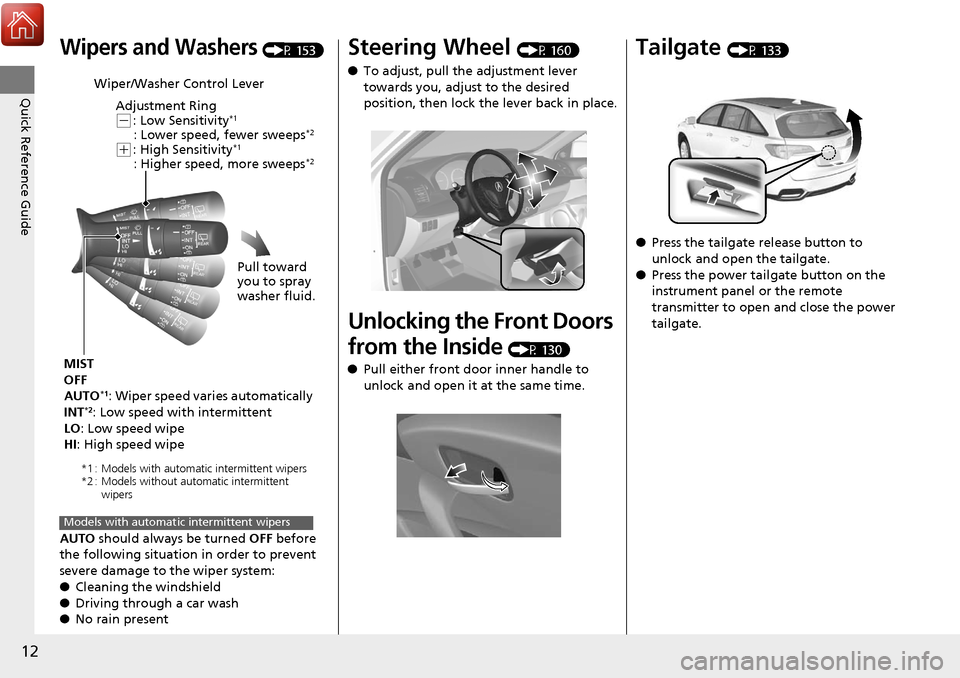
12
Quick Reference Guide
Wipers and Washers (P 153)
AUTO should always be turned OFF before
the following situation in order to prevent
severe damage to the wiper system:
● Cleaning the windshield
● Driving through a car wash
● No rain present
Wiper/Washer Control Lever
Adjustment Ring
(-: Low Sensitivity*1
: Lower speed, fewer sweeps*2
(+: High Sensitivity*1
: Higher speed, more sweeps*2
MIST
OFF
AUTO
*1: Wiper speed varies automatically
INT*2: Low speed with intermittent
LO : Low speed wipe
HI: High speed wipe Pull toward
you to spray
washer fluid.
*1 : Models with automatic intermittent wipers
*2 : Models without automatic intermittent
wipers
Models with automatic intermittent wipers
Steering Wheel (P 160)
● To adjust, pull the adjustment lever
towards you, adjust to the desired
position, then lock the lever back in place.
Unlocking the Front Doors
from the Inside
(P 130)
● Pull either front door inner handle to
unlock and open it at the same time.
Tailgate (P 133)
● Press the tailgate release button to
unlock and open the tailgate.
● Press the power tailgate button on the
instrument panel or the remote
transmitter to open and close the power
tailgate.
Page 15 of 453
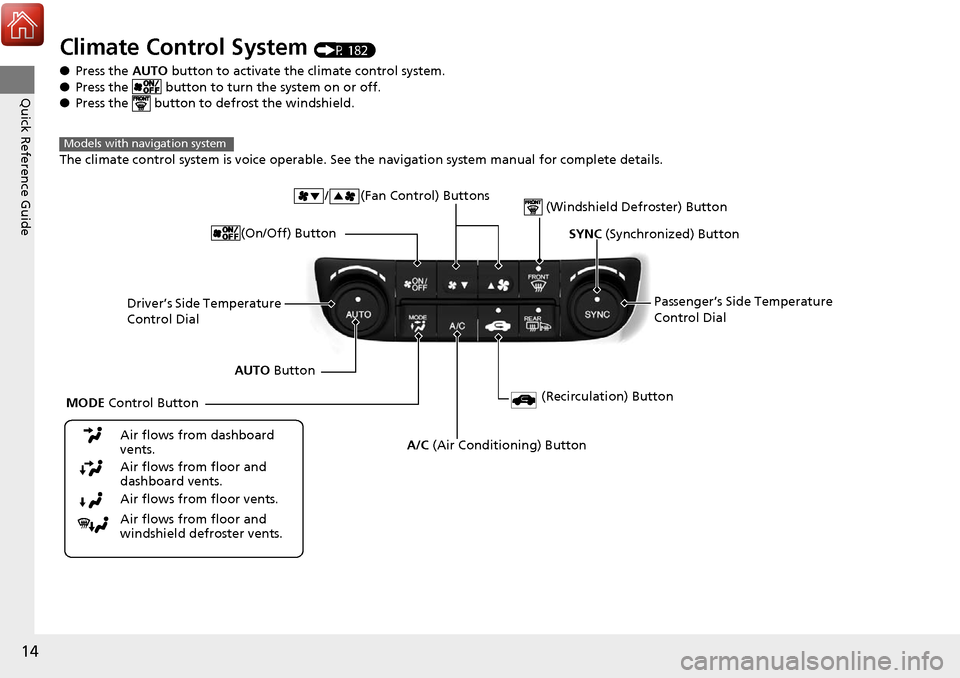
14
Quick Reference Guide
Climate Control System (P 182)
● Press the AUTO button to activate the climate control system.
● Press the button to turn the system on or off.
● Press the button to de frost the windshield.
The climate control system is voice operable. See the navigation system manual for complete details.
Models with navigation system
Driver’s Side Temperature
Control Dial / (Fan Control) Buttons
(Windshield Defroster) Button
A/C
(Air Conditioning) Button
Air flows from floor and
windshield defroster vents. Air flows from floor vents. Air flows from floor and
dashboard vents. Air flows from dashboard
vents.
SYNC (Synchronized) Button
(Recirculation) Button
AUTO Button Passenger’s Side Temperature
Control Dial
MODE Control Button (On/Off) Button
Page 19 of 453
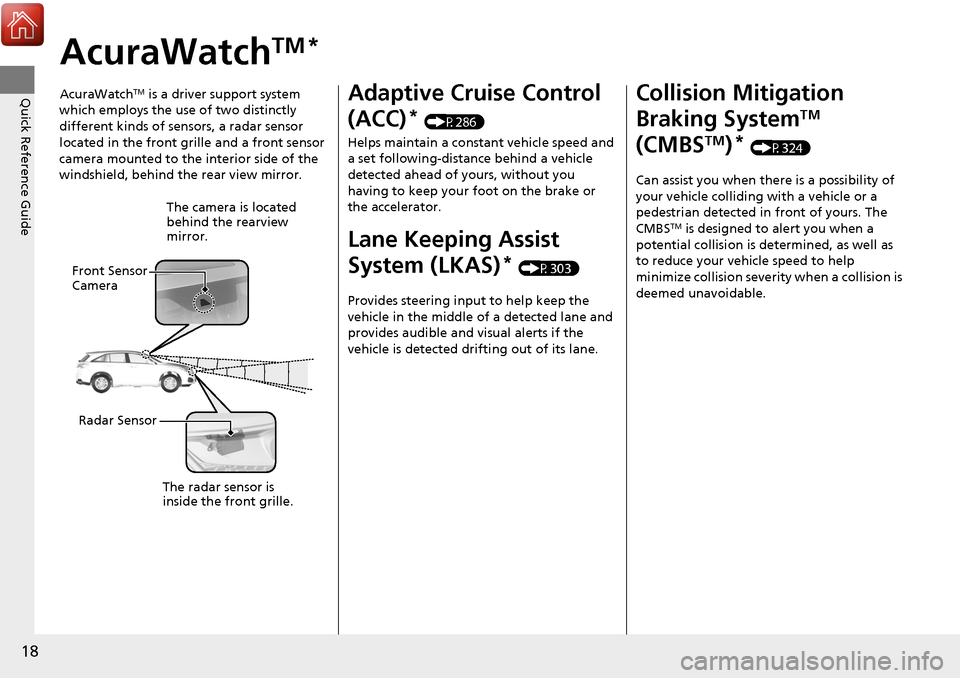
18
Quick Reference Guide
AcuraWatchTM *
AcuraWatchTM is a driver support system
which employs the use of two distinctly
different kinds of sensors, a radar sensor
located in the front grille and a front sensor
camera mounted to the interior side of the
windshield, behind the rear view mirror.
The camera is located
behind the rearview
mirror.
Front Sensor
Camera
Radar Sensor
The radar sensor is
inside the front grille.
Adaptive Cruise Control
(ACC)
* (P286)
Helps maintain a constant vehicle speed and
a set following-distance behind a vehicle
detected ahead of yours, without you
having to keep your foot on the brake or
the accelerator.
Lane Keeping Assist
System (LKAS)
* (P303)
Provides steering input to help keep the
vehicle in the middle of a detected lane and
provides audible and visual alerts if the
vehicle is detected drifting out of its lane.
Collision Mitigation
Braking System
TM
(CMBS
TM)* (P324)
Can assist you when there is a possibility of
your vehicle colliding with a vehicle or a
pedestrian detected in front of yours. The
CMBS
TM is designed to alert you when a
potential collision is determined, as well as
to reduce your vehicle speed to help
minimize collision severity when a collision is
deemed unavoidable.
Page 23 of 453
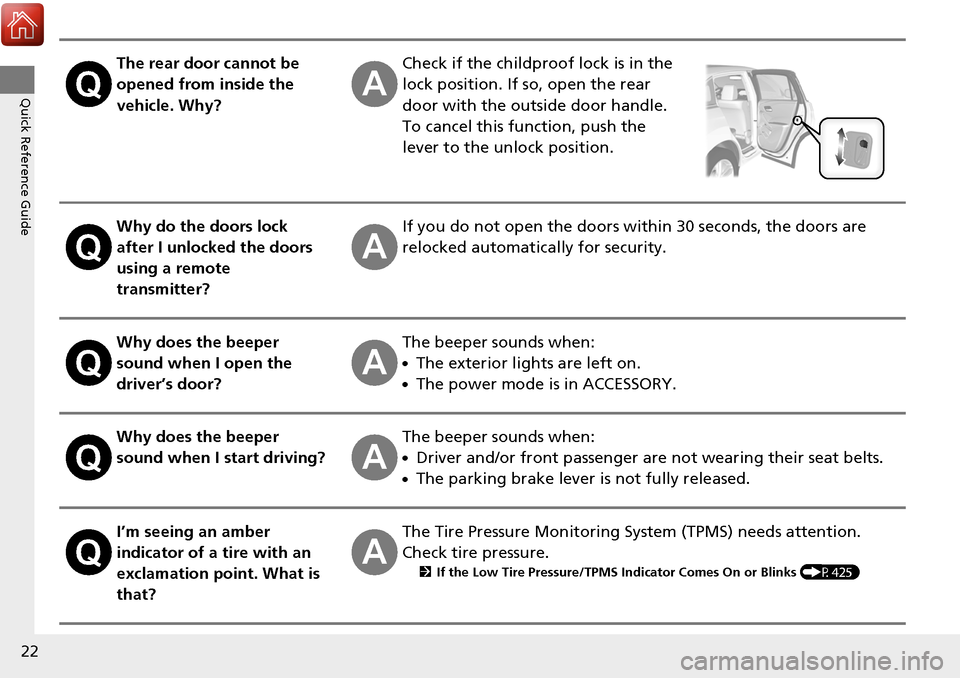
22
Quick Reference Guide
The rear door cannot be
opened from inside the
vehicle. Why?Check if the childproof lock is in the
lock position. If so, open the rear
door with the outside door handle.
To cancel this function, push the
lever to the unlock position.
Why do the doors lock
after I unlocked the doors
using a remote
transmitter?If you do not open the doors within 30 seconds, the doors are
relocked automatically for security.
Why does the beeper
sound when I open the
driver’s door?The beeper sounds when:
●The exterior lights are left on.
●The power mode is in ACCESSORY.
Why does the beeper
sound when I start driving?The beeper sounds when:
●Driver and/or front passenger are not wearing their seat belts.
●The parking brake lever is not fully released.
I’m seeing an amber
indicator of a tire with an
exclamation point. What is
that?The Tire Pressure Monitoring System (TPMS) needs attention.
Check tire pressure.
2 If the Low Tire Pressure/TPMS Indicator Comes On or Blinks (P425)
Page 26 of 453
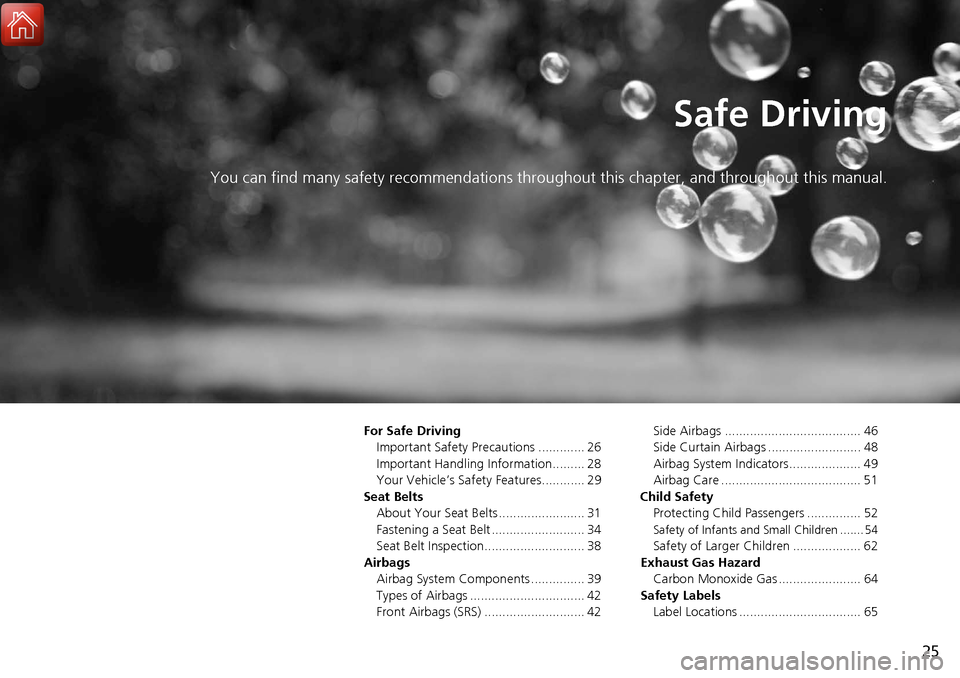
25
Safe Driving
You can find many safety recommendations throughout this chapter, and throughout this manual.
For Safe Driving
Important Safety Precautions ............. 26
Important Handling Information......... 28
Your Vehicle’s Safety Features............ 29
Seat Belts About Your Seat Belts ........................ 31
Fastening a Seat Belt .......................... 34
Seat Belt Inspection............................ 38
Airbags Airbag System Components ............... 39
Types of Airbags ................................ 42
Front Airbags (SRS) ............................ 42 Side Airbags ...................................... 46
Side Curtain Airbags .......................... 48
Airbag System Indicators.................... 49
Airbag Care ....................................... 51
Child Safety Protecting Child Passengers ............... 52
Safety of Infants and Small Children ....... 54
Safety of Larger Children ................... 62
Exhaust Gas Hazard Carbon Monoxide Gas ....................... 64
Safety Labels Label Locations .................................. 65
Page 27 of 453
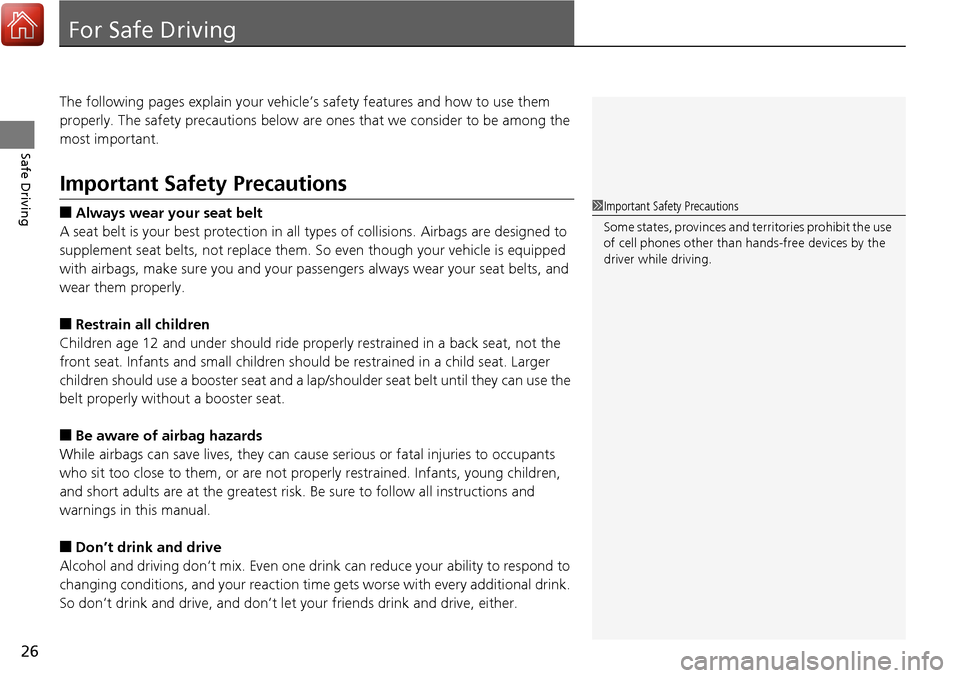
26
Safe Driving
For Safe Driving
The following pages explain your vehicle’s safety features and how to use them
properly. The safety precautions below are ones that we consider to be among the
most important.
Important Safety Precautions
■Always wear your seat belt
A seat belt is your best protection in all types of collisions. Airbags are designed to
supplement seat belts, not replace them. So even though your vehicle is equipped
with airbags, make sure you and your passen gers always wear your seat belts, and
wear them properly.
■Restrain all children
Children age 12 and under should ride prop erly restrained in a back seat, not the
front seat. Infants and small children shoul d be restrained in a child seat. Larger
children should use a booster seat and a lap/ shoulder seat belt until they can use the
belt properly without a booster seat.
■Be aware of airbag hazards
While airbags can save lives, they can caus e serious or fatal injuries to occupants
who sit too close to them, or are not prop erly restrained. Infants, young children,
and short adults are at the greatest risk. Be sure to follow all instructions and
warnings in this manual.
■Don’t drink and drive
Alcohol and driving don’t mix. Even one dr ink can reduce your ability to respond to
changing conditions, and your reaction time gets worse with every additional drink.
So don’t drink and drive, and don’t let your friends drink and drive, either.
1Important Safety Precautions
Some states, provinces and territories prohibit the use
of cell phones other than hands-free devices by the
driver while driving.
Page 30 of 453

29
uuFor Safe Driving uYour Vehicle’s Safety Features
Continued
Safe Driving
Your Vehicle’s Safety Features
The following checklist will he lp you take an active role in protecting yourself and
your passengers.
1 Your Vehicle’s Safety Features
Your vehicle is equipped wi th many features that
work together to help protect you and your
passengers during a crash.
Some features do not require any action on your part.
These include a strong steel framework that forms a
safety cage around the passenger compartment,
front and rear crush zone s, a collapsible steering
column, and tensioners that tighten the front seat
belts in a sufficient crash.
However, you and your passe ngers cannot take full
advantage of these features unless you remain seated
in the correct position and always wear your seat
belts. In fact, some safety features can contribute to
injuries if they are not used properly.
678910
Safety Cage
Crush Zones
Seats and Seat-Backs
Head Restraints
Collapsible Steering Column
Seat Belts
Front Airbags
Side Curtain Airbags
Door Locks Side Airbags
11Seat Belt Tensioners
6
7
7
8
8
99
10
10
11